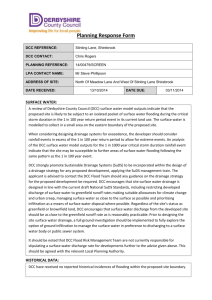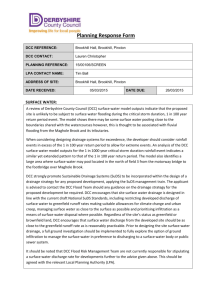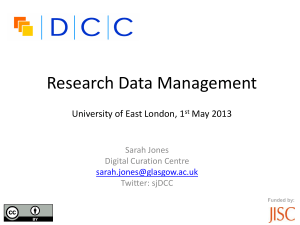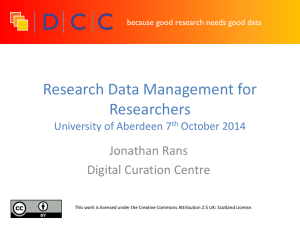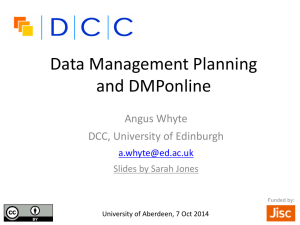Consultee Comment-2008469.pdf
advertisement
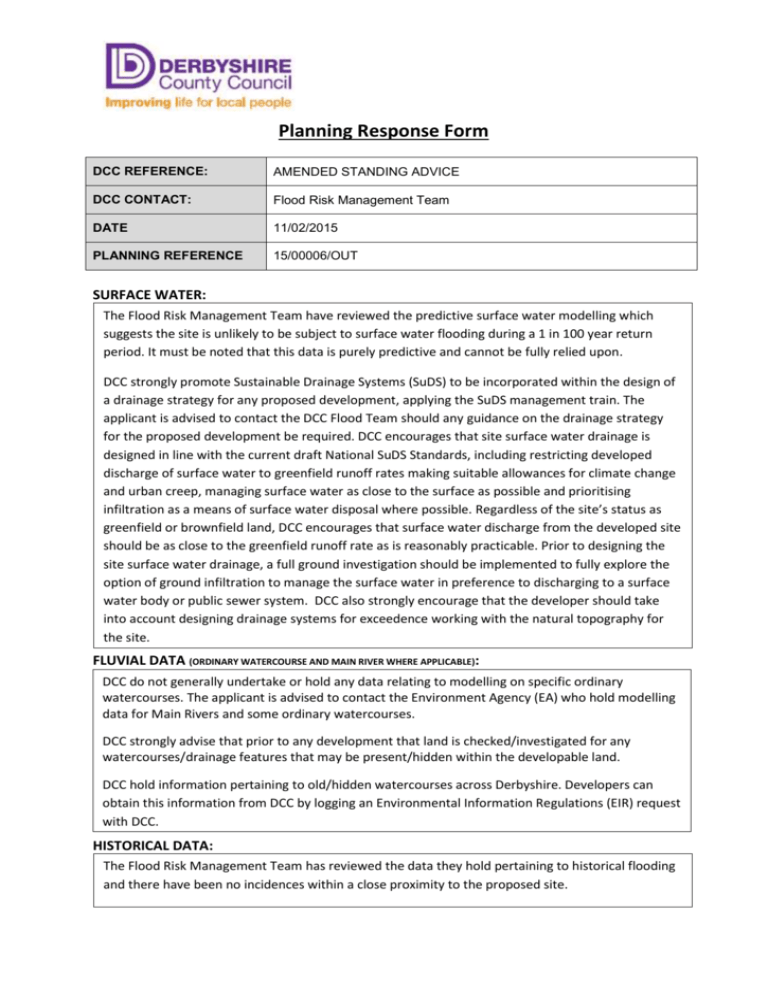
Planning Response Form DCC REFERENCE: AMENDED STANDING ADVICE DCC CONTACT: Flood Risk Management Team DATE 11/02/2015 PLANNING REFERENCE 15/00006/OUT SURFACE WATER: The Flood Risk Management Team have reviewed the predictive surface water modelling which suggests the site is unlikely to be subject to surface water flooding during a 1 in 100 year return period. It must be noted that this data is purely predictive and cannot be fully relied upon. DCC strongly promote Sustainable Drainage Systems (SuDS) to be incorporated within the design of a drainage strategy for any proposed development, applying the SuDS management train. The applicant is advised to contact the DCC Flood Team should any guidance on the drainage strategy for the proposed development be required. DCC encourages that site surface water drainage is designed in line with the current draft National SuDS Standards, including restricting developed discharge of surface water to greenfield runoff rates making suitable allowances for climate change and urban creep, managing surface water as close to the surface as possible and prioritising infiltration as a means of surface water disposal where possible. Regardless of the site’s status as greenfield or brownfield land, DCC encourages that surface water discharge from the developed site should be as close to the greenfield runoff rate as is reasonably practicable. Prior to designing the site surface water drainage, a full ground investigation should be implemented to fully explore the option of ground infiltration to manage the surface water in preference to discharging to a surface water body or public sewer system. DCC also strongly encourage that the developer should take into account designing drainage systems for exceedence working with the natural topography for the site. FLUVIAL DATA (ORDINARY WATERCOURSE AND MAIN RIVER WHERE APPLICABLE): DCC do not generally undertake or hold any data relating to modelling on specific ordinary watercourses. The applicant is advised to contact the Environment Agency (EA) who hold modelling data for Main Rivers and some ordinary watercourses. DCC strongly advise that prior to any development that land is checked/investigated for any watercourses/drainage features that may be present/hidden within the developable land. DCC hold information pertaining to old/hidden watercourses across Derbyshire. Developers can obtain this information from DCC by logging an Environmental Information Regulations (EIR) request with DCC. HISTORICAL DATA: The Flood Risk Management Team has reviewed the data they hold pertaining to historical flooding and there have been no incidences within a close proximity to the proposed site. GROUNDWATER DATA: Development located in areas where the water table is at a shallow depth below the ground surface may be susceptible to groundwater flooding. In such areas, development may lead to groundwater flooding at the development site and in the close vicinity as well as potential land instability, geohazards and groundwater contamination. Development site drainage should be considered carefully to avoid any increased risks associated with groundwater. DCC would not recommend infiltration as a means of development site surface water disposal in areas where geohazards or ground instability is deemed likely without appropriate analysis of the risks involved. Infiltration of surface water to the ground is also not advised in sensitive groundwater areas without an appropriate SuDS management train. It is recommended that a site specific ground investigation is undertaken for the site to ascertain the water conditions on the proposed development site. WATER FRAMEWORK DIRECTIVE/WATER ENVIRONMENT DATA: Under the Water Framework Directive (WFD), all water bodies should reach ‘good ecological status’ by 2015. No activities or works, including the proposed development, should deteriorate the status of any nearby watercourse as the main objectives for the WFD is to prevent deterioration in ‘status’ for all waterbodies. The ecological health of any receiving watercourse can be protected by the implementation of a SuDS scheme with an appropriate number of treatment stages that are appropriately maintained. Current WFD ecological status of all assessed water bodies is available on the EA website. DCC recommends that where there is any potential for the existing habitat of protected species (for example great crested newt, native white clawed crayfish, water vole, bats or otter species) on the proposed development site, the applicant should undertake an appropriate ecological assessment by a competent ecologist prior to starting works on site. It is an offence to undertake works which adversely affect any legally protected species or habitat without appropriate mitigation measures in place. OTHER RELEVANT INFORMATION AND COMMENTS: Following the 2007 Pitt Review recommendation, Schedule 3 of the Flood and Water Management Act (2010) designated DCC as the SuDS Approval Body (SAB). Following the enactment of this legislation, DCC would be responsible for approving all construction with drainage implications and adopting any approved SuDS. However, Defra released a consultation on 12th September 2014 which outlined an alternative way of delivering SuDS through amendments to existing planning guidance. Depending on the outcome of this consultation, the SAB may not be required and Local Planning Authorities (LPAs) may have the duty to approve SuDS systems for new developments, with assistance from a range of consultees. This alternative solution may come into force in April 2015. DCC do not currently adopt any private SuDS schemes. As such, should a SuDS solution be proposed for this development, it should be confirmed prior to commencement of works who the responsible organisation for SuDS maintenance will be once the development is complete. As of the 6th April 2012 the FWMA transposed consenting powers under the Land Drainage Act to DCC (the LLFA). Therefore any works in or nearby to an ordinary watercourse require consent from DCC. (e.g. an outfall that encroaches into the profile of the watercourse, etc) would require consent under the Land Drainage Act (LDA) 1991 from the consent authoriser (Derbyshire County Council Flood Risk Management Team). Upon receipt of any application (including the legislative fee) DCC has an 8 week legislative period in which to make a decision and either consent or object the proposals. If the applicant wishes to make an application for any works please contact Flood.Team@derbyshire.gov.uk.
